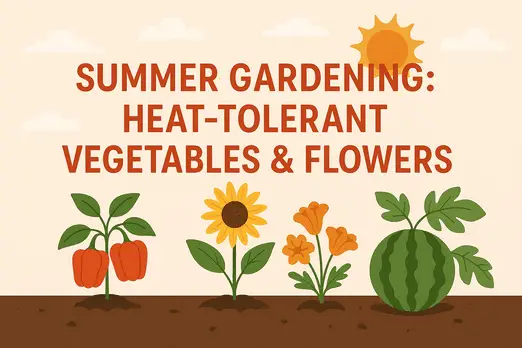Summer Gardening: Thriving in the Heat with Heat-Tolerant Vegetables and Flowers
Summer gardening presents unique challenges, primarily the intense heat. However, with careful planning and selection of heat-tolerant varieties, you can still enjoy a vibrant and productive garden throughout the warmest months. This comprehensive guide explores the best heat-tolerant vegetables and flowers, providing valuable tips for successful summer gardening.
JUMP TO TOPIC
Choosing Heat-Tolerant Vegetables
The key to success in summer vegetable gardening is selecting varieties specifically bred to withstand high temperatures and drought conditions. These plants often possess adaptations such as deep root systems for accessing water and thick leaves to reduce water loss through transpiration. Consider the following options:
1. Leafy Greens with a Heat Advantage:
While many leafy greens struggle in extreme heat, some perform surprisingly well. Heat-tolerant lettuce varieties like ‘Black Seeded Simpson’ and ‘Red Sails’ offer a degree of resilience. Spinach can be grown in cooler parts of the garden or with afternoon shade. However, it’s crucial to harvest these greens frequently to prevent bolting (premature flowering) in intense heat.
2. Thriving in the Sun: Summer Squash & Zucchini:
Summer squash and zucchini are prolific producers in hot weather. Their rapid growth cycle allows them to mature before the most intense heat sets in. Plant them in well-drained soil and ensure consistent watering, particularly during fruiting.
3. Heat-Loving Peppers and Tomatoes:
Peppers and tomatoes are known for their heat tolerance. Choose determinate varieties for peppers, which produce a concentrated crop over a shorter period, ideal for summer. For tomatoes, look for heat-tolerant varieties like ‘Roma VF’ or ‘Celebrity’. Proper mulching helps conserve soil moisture and moderate soil temperatures, crucial for these heat-loving plants.
4. Beans for the Scorching Sun:
Bush beans are particularly well-suited to summer conditions. Their relatively short growing season allows them to produce a crop before the heat becomes overwhelming. Pole beans can also be successfully grown, but providing adequate support and watering is crucial.
5. Root Vegetables That Tolerate Heat:
Certain root vegetables are surprisingly adaptable to summer heat. Carrots, particularly those with shorter maturation times, can produce well in summer if planted early or in cooler microclimates. Beets are also relatively heat-tolerant. Consider planting them in a slightly shaded area to ensure optimal growth.
Essential Care for Heat-Tolerant Vegetables
Even heat-tolerant vegetables require specific care to thrive in summer’s extreme conditions:
1. Watering Wisely:
Consistent watering is crucial, especially during hot and dry spells. Deep, infrequent watering encourages deep root growth, making plants more drought-tolerant in the long run. Avoid overhead watering, which can lead to fungal diseases in humid conditions. Instead, opt for drip irrigation or soaker hoses.
2. Mulching for Moisture Retention:
Apply a layer of organic mulch, such as straw or wood chips, around plants. Mulch helps retain soil moisture, suppress weeds, and moderate soil temperature, creating a more favourable environment for your vegetables.
3. Providing Shade:
In extremely hot areas, consider providing afternoon shade for sensitive plants. This can be achieved using shade cloth, strategically placed taller plants, or other shading structures.
4. Monitoring for Pests and Diseases:
Hot, humid conditions can increase the risk of pest and disease problems. Regularly inspect your plants for signs of infestation or disease and take appropriate action promptly. Using organic pest control methods is beneficial for both the environment and your health.
Choosing Heat-Tolerant Flowers
Summer’s intense heat doesn’t mean you have to sacrifice the beauty of flowers. Many bloom prolifically and vibrantly in hot weather conditions. Select varieties known for their heat and drought tolerance:
1. Sun-Loving Annuals:
Zinnias are quintessential summer annuals, boasting a wide range of colors and thriving in full sun. Cosmos are another excellent choice, with their delicate petals and ability to tolerate drought conditions. Marigolds are known for their pest-repelling properties and their ability to handle extreme heat. Portulaca (moss rose) is a low-growing ground cover that thrives in hot, dry locations, offering a carpet of colourful blooms.
2. Resilient Perennials:
Many perennials adapt well to summer’s challenges. Coneflowers (Echinacea) are a hardy choice, attracting pollinators with their daisy-like blooms. Lavender prefers full sun and well-drained soil, offering fragrant purple blooms throughout summer. Russian Sage (Perovskia) tolerates drought and extreme heat, providing a long season of silvery-blue foliage and flowers.
3. Colourful Choices for Hot Climates:
Lantana is a vibrant shrub that produces clusters of colourful flowers throughout the summer. Daylilies offer a wide variety of colours and bloom times, making them a versatile option for summer gardens. Salvia, with its tall spires of colourful flowers, attracts hummingbirds and butterflies while thriving in the heat.
Essential Care for Heat-Tolerant Flowers
Similar to vegetables, heat-tolerant flowers require careful attention to thrive in summer’s heat:
1. Water Deeply but Infrequently:
Deep watering encourages strong root systems, making plants more resilient to drought. Allow the soil to dry slightly between waterings to prevent root rot.
2. Mulch to Conserve Moisture:
Mulching around plants helps retain soil moisture, reducing the frequency of watering and suppressing weeds.
3. Deadhead Regularly:
Deadheading, or removing spent blooms, encourages continuous flowering and prevents the plant from putting energy into seed production.
4. Fertilize Appropriately:
Use a balanced fertilizer to provide the necessary nutrients for vigorous growth and abundant blooms. Avoid over-fertilizing, as this can lead to excessive leaf growth at the expense of flowers.
5. Protect from Intense Sun:
While most heat-tolerant flowers thrive in full sun, even they can benefit from some protection during the hottest part of the day, especially newly planted specimens. Afternoon shade can help them stay hydrated and prevent wilting.
By carefully selecting heat-tolerant vegetables and flowers and employing the right gardening techniques, you can enjoy a vibrant and productive garden even during the hottest summer months. Remember that consistent observation and adaptation are key to successful summer gardening.

